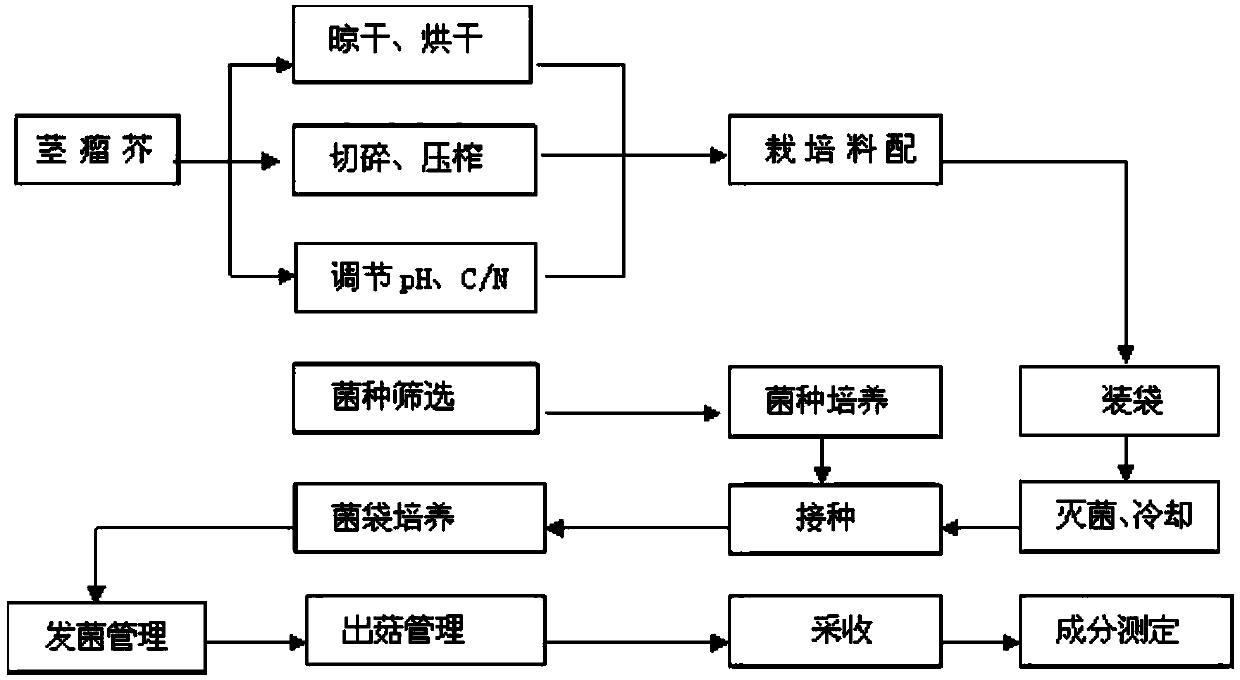Method for cultivating oyster mushroom by using tumorous stem mustard leaves
The technology of stem nodule mustard leaves and oyster mushroom is applied in the field of edible fungus cultivation, which can solve the problems of discarding, pollution, waste of resources and the environment, and achieves the effects of avoiding waste of resources, increasing the income of vegetable farmers and being beneficial to environmental protection.
- Summary
- Abstract
- Description
- Claims
- Application Information
AI Technical Summary
Problems solved by technology
Method used
Image
Examples
Embodiment 1
[0023] Preparation of the culture medium: add 4% to 5% lime to the mustard leaf scraps, adjust the pH value of the mustard leaf scraps to 7-8, and then add 20% of the stem mustard leaves, 40% of the cottonseed hulls, bran Skin 5% is mixed according to the ratio, then add water, stir and mix evenly, so that the water content of the medium reaches 60% to 65%;
[0024] Cultivation method: collect the stem mustard leaves, take fresh stem mustard leaves, grind them into stem mustard leaf scraps with a fineness of 0.5-2 cm with a feed mill, cool until dry, put the culture medium into the poly Acrylic plastic bag, the specification of the plastic bag is 23-28cm in folded diameter, 40-50cm in length, first tie one end of the plastic simple bag tightly with a rope, put in the culture material, compact it while loading, level it firmly, and tie it tightly with a rope , the material bags are put into the sterilization frame, 4 to 6 material bags per frame, and sterilized in the autoclave...
Embodiment 2
[0026] Preparation of the culture medium: add 5% lime to the mustard leaf scraps, adjust the pH value of the mustard leaf scraps to 8, then add 40% of the mustard leaves, 45% of the cottonseed hulls, and 15% of the bran according to the proportion Mix well, then add water, stir and mix evenly, so that the water content of the culture medium reaches 65%;
[0027] Cultivation method: collect the stem mustard leaves, take fresh stem mustard leaves, grind them into stem mustard leaf scraps with a fineness of 0.5-2 cm with a feed mill, cool until dry, put the culture medium into the poly Acrylic plastic bag, the specification of the plastic bag is 23-28cm in folded diameter, 40-50cm in length, first tie one end of the plastic simple bag tightly with a rope, put in the culture material, compact it while loading, level it firmly, and tie it tightly with a rope , the material bags are put into the sterilization layer frame, 6 bags per layer, and sterilized in the normal pressure steri...
Embodiment 3
[0029] Preparation of the culture medium: add 4.5% lime to the mustard leaf scraps, adjust the pH value of the mustard leaf scraps to 7.5, then add 30% of the mustard leaves, 60% of the cottonseed hulls, and 10% of the bran according to the proportion Mix well, then add water, stir and mix evenly, so that the water content of the medium reaches 60%;
[0030] Cultivation method: collect the stem mustard leaves, take fresh stem mustard leaves, grind them into stem mustard leaf scraps with a fineness of 0.5-2 cm with a feed mill, cool until dry, put the culture medium into the poly Acrylic plastic bag, the specification of the plastic bag is 23-28cm in folded diameter, 40-50cm in length, first tie one end of the plastic simple bag tightly with a rope, put in the culture material, compact it while loading, level it firmly, and tie it tightly with a rope , the material bags are put into the sterilization frame, 5 bags per frame, and sterilized in the autoclave. When sterilizing in ...
PUM
| Property | Measurement | Unit |
|---|---|---|
| Diameter | aaaaa | aaaaa |
| Length | aaaaa | aaaaa |
| Diameter | aaaaa | aaaaa |
Abstract
Description
Claims
Application Information
 Login to View More
Login to View More - Generate Ideas
- Intellectual Property
- Life Sciences
- Materials
- Tech Scout
- Unparalleled Data Quality
- Higher Quality Content
- 60% Fewer Hallucinations
Browse by: Latest US Patents, China's latest patents, Technical Efficacy Thesaurus, Application Domain, Technology Topic, Popular Technical Reports.
© 2025 PatSnap. All rights reserved.Legal|Privacy policy|Modern Slavery Act Transparency Statement|Sitemap|About US| Contact US: help@patsnap.com



